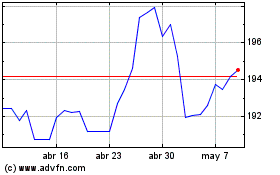Pound Retreats As U.K. Inflation Slows To Two-year Low
13 Febrero 2019 - 12:17AM
RTTF2
The pound trimmed its early gains against its major counterparts
in the European session on Wednesday, as U.K. consumer inflation
slowed to a two-year low in January, below the Bank of England's
target of 2 percent.
Data from the Office for National Statistics showed that the
consumer price index rose 1.8 percent year-on-year following a 2.1
percent increase in December. Economists had expected 2 percent
inflation.
Headline inflation was the slowest since January 2017, when
prices rose at the same pace.
Core inflation was steady at 1.9 percent at the start of the
year, in line with economists' expectations.
ONS data also showed that input price inflation eased to 2.9
percent from a revised 3.2 percent. In contrast, economists had
expected a faster rate of 3.8 percent.
The core input price inflation slowed to 4.6 percent from 4.7
percent. Output price inflation eased to 2.1 percent from a revised
2.4 percent in December, which was slightly slower than the 2.2
percent economists had predicted.
The core output price inflation was steady at 2.4 percent in
January.
Another report from ONS showed that UK house price inflation
slowed to 2.5 percent in December from 2.7 percent in November, in
line with economists' expectations.
The latest house price growth figure was the lowest since July
2013, when it was 2.3 percent.
The currency was higher against its most major counterparts in
the Asian session, excepting the euro.
The pound fell to 1.2882 against the greenback, down from a
2-day high of 1.2923 hit at 1:45 am ET. The pair was worth 1.2890
at yesterday's close. On the downside, 1.27 is likely seen as the
next support level for the pound.
Pulling away from an 8-day high of 142.96 hit at 1:00 am ET, the
pound retreated to 142.58 against the yen. If the pound falls
further, 140.00 is possibly seen as its next support level.
Data from the Bank of Japan showed that Japan producer prices
fell 0.6 percent on month in January - unchanged from the December
reading but well shy of expectations for a decline of 0.2
percent.
On a yearly basis, producer prices climbed 0.6 percent - again
missing forecasts for 1.0 percent and down from 1.5 percent in the
previous month.
Having climbed to 1.2999 against the Swiss franc at 2:45 am ET,
the pound reversed direction and moved down to 1.2955. The next
possible support for the pound is seen around the 1.27 region.
The U.K. currency eased back to 0.8791 against the euro, just
short of few pips from a 6-day low of 0.8793 hit at 7:00 pm ET. The
pound is seen finding support around the 0.89 mark.
Data from Eurostat showed that Eurozone industrial production
decreased for a second straight month and at a faster-than-expected
pace in December, but the fall was less severe than the previous
month's decline.
Industrial production fell 0.9 percent from November, when it
decreased 1.7 percent. Economists had expected a 0.4 percent
decline.
Looking ahead, U.S. consumer price index for January and monthly
budget statement for December are scheduled for release in the New
York session.
Sterling vs Yen (FX:GBPJPY)
Gráfica de Divisa
De Mar 2024 a Abr 2024

Sterling vs Yen (FX:GBPJPY)
Gráfica de Divisa
De Abr 2023 a Abr 2024
